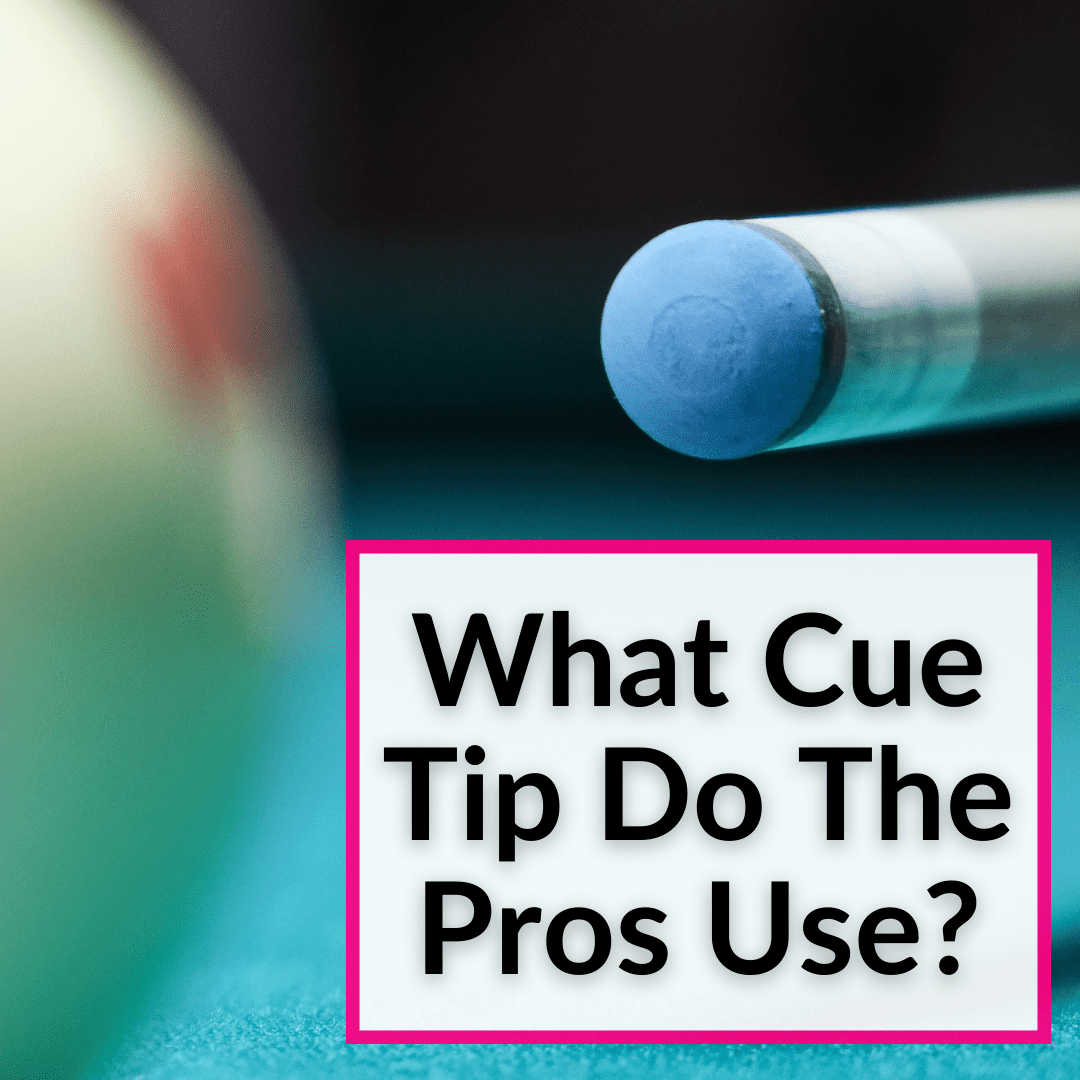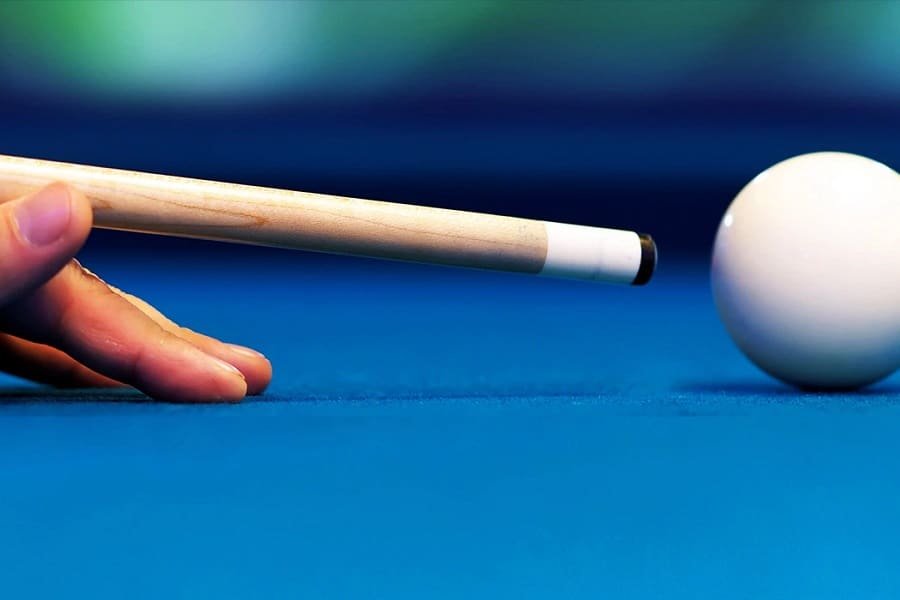 It’s not easy to identifying what type of cue tip a professional player is using.
It’s not easy to identifying what type of cue tip a professional player is using.
Plus, it’s not always going the be the tip they prefer.
Many pros use the cue tip that is available during a particular game, as provided by the club or as part of a sponsorship deal.
But we can tell you which type of cue tip most pros prefer. We’ll also tell you why they prefer that type.
And all of this will help you figure out which type of cue tip is best for you.
Table of Contents
What Cue Tip Do The Pros Use?
A lot of people don’t know this but the cue tip and the first six inches of the cue stick play a major role in how a game turns out. Even if you have the best pool stick you can afford, a bad tip makes it useless.
Unless you’re a billiards enthusiast, you probably don’t know that there are many kinds of cue tips either. Or why the tip makes a difference.

We’ll cover it all below, and help you bring your best game to the table.
A percentage of pool pros use what suits them better, while the rest use cue tips from their sponsors, be it hard or soft.
These days, the number of cue tips to pick from is overwhelming, especially if you are a complete beginner. Add to that the different options for pool stick material, like wood or graphite.
But worry no more. By the end of this article, you’ll have an idea of where to begin.
Let’s start with some basic information on cue tips and then move on to the different types and which type is preferred by pro players.
Basic Information

Chances are high you already know what a cue tip is. If that is the case, feel free to skip this section.
For everyone else, a cue tip is the rubbery part at the end of a cue stick. It serves to transfer energy from your shot to the white cue ball.
These tips come in different diameters and shapes. Some are more rounded than others, while some are flatter. The shape, texture, and material of the cue tip influence the speed, accuracy, and spin of your shot, which is why it’s so important.
Rounded cue tips are the best for adding English to the ball, while the flat ones are excellent for making the cue ball swerve and spin.
With time and use, a cue tip can become too smooth and worn which is where the chalk comes in. The chalk is used to restore friction to your cue tip so it doesn’t slip past the ball when you’re shooting.
Contrary to popular belief, pool break cue tips are generally made from hardened leather or phenolic resin, not rubber.
This is because rubber absorbs impact and therefore won’t fully channel the force of your shot to the ball. A cue tip requires tough material that doesn’t break or wear out midgame.
Now let’s take a closer look at the different types of cue tips and how they differ from one another.
Different Cue Tips

Your cue stick is your primary weapon against an opponent in a competitive snooker or billiards game. To give yourself the best chance of winning, you want to select the best cue with the best tip.
A good pool stick is so important that some players invest hundreds, even thousands, of dollars into purchasing the finest one.
The main difference between different types of cue tips is how soft or hard they are, which is determined by the material used to make the tip.
Pro players generally prefer soft cue tips because they provide maximum control over the ball. On the other hand, hard tips hold their shape longer and thus require less maintenance.
In the end, everything boils down to your preference. To give you an idea of which type of cue tip is best for you, let’s take a closer look at the different cue tips and their advantages and disadvantages.
Soft Cue Tips
Soft cue tips make contact with the ball for a slightly longer time and use compression to help you guide your shots better. A smooth and controlled gameplay experience is important, but the downside of soft cue tips is they wear out faster.
This type of cue tip needs to be maintained and replaced more often, sometimes even during the course of a single game. Soft cue tips are generally made from tanned leather. The best soft tips are made from pure cow leather.
Hard Cue Tips
As the name suggests, hard cue tips are tougher and impact the ball for a very short duration. And usually with a soft thudding sound.
A hard tip doesn’t offer the same precision as a soft on, but it lasts much longer. This is why most bars, clubs, or college campuses with pool tables tend to keep low-maintenance hard cues. They’re easier on the budget.
Hard cue tips are made from toughened water buffalo skin, pigskin, or boar skin, although you can also find some low-quality synthetic ones made from plastic, phenolic resin, or artificial leather.
Hard cue tips are often used for breaking and jump shots because they transfer the force from the cue much more efficiently. They are not the best for accuracy, but hard cue tips definitely add power to your shot.
Medium-Hard Cue Tips
Medium-hard cue tips are pretty decent performance-wise. They’re helpful when it comes to directing shots and require an average amount of maintenance.
Medium-hard tips are usually made from layers of leather which allow players to adjust the consistency and hardness of the tip. Medium-hard cue tips are great for free playing, if you’re a pool hobbyist.
Other Cue Tips
The above-mentioned cue tips are the most common types on the market, but there are a few specialty cues that take a particular physical trait to an extreme level. For instance, super-hard or super-soft tips.
When you’re playing a unique game or have an unorthodox playing strategy, you can use these cues to cater to your varying needs and preferences.
Cue Tips Pro Players Prefer

Experts recommend cues with soft tips for competitive games, because they offer a much higher degree of control and accuracy.
The cushioning and elastic effects of the cue also make it much easier to spin the ball for trick shots when you’re in a pinch. A majority of professional players use cues with soft tips.
Some professionals, however, enjoy the challenge of a hard cue tip. They train themselves to be able to use super hard cue tips to give their shots both power and accuracy.
In most professional matches, you can’t change your cue stick to a harder one if you need power for a particular shot, so learning how to play this way has its advantages.
Pros like Van Boening are a good example. He makes use of hard cue tips because his style requires less chalk and more impact on the ball.
Why The Cue Tip Type Matters

The size, shape, material, and layers of your cue tip can turn the tide of a match. If you’re playing professionally or competitively, it matters a great deal because it has the potential to change the gameplay experience.
It’s essential to be aware of your gaming style. If you want to improve your game, make sure the cue tip on your current cue stick is the right choice for your playing style. Don’t just use whatever tip is available.
And when you make the switch, you’ll need to adjust to a particular cue tip after understanding the strengths and weaknesses each offers. Here are some key facts to keep in mind.
- The shorter the tip, the more power in the shot. A shorter cue tip absorbs just a small amount of impact to help you guide the shot. If your cue tip is short, more force is transferred to the cue ball.
- The harder the tip, the tougher it is to spin the cue ball.
- Hard tips last longer and need to be maintained less often than soft cue tips.
- Each player has his or her own style and way of playing the game, so you should experiment with different cue tip types to find your ideal match.
- The softest quality cue tip available today is made from layered pigskin and the hardest one is made from nine layers of laminated calfskin.
Why & When To Use A Hard Cue Tip
- Hard cue tips are great for break shots
- Require very little maintenance and do not mushroom quickly
- Last longer than the softer ones
- Used while making jump cues
Why & When To Use A Soft Cue Tip
- Great for finesse shots
- Suitable for players that make soft touches
- Require the right mix of power to hit the ball
- Allow you to put English on the cue ball
Cue Tips The Pros Use: Conclusion
To recap: most billiards professionals prefer soft-skinned cue tips made from cow leather because they make precision shots easier. However, it’s still an individual choice.
It’s possible to find yourself more at ease, and performing better, with a hard cue tip once you start playing. If you haven’t tried using different cue tips, it may be a good idea to experiment until you find the right one for you.
Leave a Reply